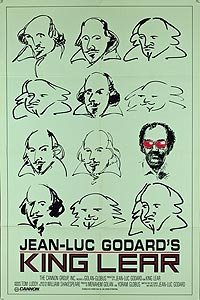King Lear |
      • Directed by: Jean-Luc Godard. • Starring: Woody Allen, Freddy Buache, Leos Carax, Julie Delpy, Jean-Luc Godard, Suzanne Lanza, Kate Mailer, Norman Mailer, Burgess Meredith, Michèle Pétin, Molly Ringwald, Peter Sellars.. • Directed by: Jean-Luc Godard. • Starring: Woody Allen, Freddy Buache, Leos Carax, Julie Delpy, Jean-Luc Godard, Suzanne Lanza, Kate Mailer, Norman Mailer, Burgess Meredith, Michèle Pétin, Molly Ringwald, Peter Sellars..      Everything returns to normal after Chernobyl. That is, everything but art. Most of the great works are lost, and it is up to people like William Shakespear Junior the Fifth to restore the lost artwork of the human race. He finds strange goings-on at a resort enough to remind him of all the lines of the play, dealing with mob boss Don Learo and his daughter Cordelia, a strange professor named Jean Luc-Godard (sic), who repeatedly xeroxes his hand for no particular reason. He is followed by four humanoid goblins that keep tormenting Cordelia. There is also the gentleman whose girlfriend, Valerie, isn't always visible. Then the film is sent off to New York for Mr. Alien to edit. Everything returns to normal after Chernobyl. That is, everything but art. Most of the great works are lost, and it is up to people like William Shakespear Junior the Fifth to restore the lost artwork of the human race. He finds strange goings-on at a resort enough to remind him of all the lines of the play, dealing with mob boss Don Learo and his daughter Cordelia, a strange professor named Jean Luc-Godard (sic), who repeatedly xeroxes his hand for no particular reason. He is followed by four humanoid goblins that keep tormenting Cordelia. There is also the gentleman whose girlfriend, Valerie, isn't always visible. Then the film is sent off to New York for Mr. Alien to edit.
|
Review:







It opens with an actual phonecall from the producer giving Godard a roasting for failing to deliver the film. The film that follows is Godard's response and is basically a middle finger to the Cannon Group and everyone else, focussing as it does, on the key word in the play: Nothing.
In the opening scenes, Norman Mailer and his daughter discuss the King Lear script he has just finished. It's unclear whether Mailer's actual script was ever going to be used, assuming he wrote one, or why Mailer himself would want to act the part, or why Godard would ever have agreed to make a film written and acted by Norman Mailer. Obscurities matched only by the resulting film itself. In any case it wasn't going to work. Perhaps to deliberately abort the project, Godard quickly succeeded in pissing off the Mailers who left in a huff. Godard blames the petulance of 'the great writer' and his daughter's inability to handle the pressure from various sides, including her father. That's one hell of an opening for a film, leaving us blinking and wondering what is going to happen, or not happen, next.
A kind of story pops up. A descendant of Shakespeare (Peter Sellars) is trying to recreate the Bard's works after all art has been lost in a nuclear catastrophe. In a Swiss hotel he finds Burgess Meredith and Molly Ringwald, vaguely recognised as Lear and Cordelia (power and virtue in contest), and from whom he gradually reconstructs the play. Mailer's idea of making Lear a mafia don resurfaces here. Meanwhile, Sellars is in pursuit of the mad Professor Pluggy (Godard, in a truly bizarre performance) who has crucial knowledge of how images should complement the words.
Pluggy's long and solemn thesis on words, images and reality is at the centre of the film. Life and images of life.Telling and showing. There is more than recreating a universe of words (says Pluggy). Images are purer. Images serve to connect two realities and meaning is created by reconciling these two realities. Their coming together in image form releases the emotive power. Contrary realities (Lear and Cordelia) don't come together. The strength of an image lies in the association of ideas it contains. Bringing them together is the function of the artist. This presumably also applies to sound - the use of sound in the film is astonishing - layered, atmospheric, and apparently insane - and presumably explains the seagulls that are heard at random intervals, even during interior scenes. This is all dream-theory. Barely understandable on a single viewing - perhaps complete gibberish - yet key to what the film is about: the struggle of the artist to create.
At the end, Woody Allen is splicing the film with safety pins while reciting an irrelevant Sonnet - a final swipe at the Americans who clearly should never have messed with Godard in the first place. His response was to deliver something that is probably Nothing with an artistic fiendishness ungraspable by mere mortals. According to your fondness for the director, it's either highly entertaining or unendurable punishment.
Review by federovsky from the Internet Movie Database.
Conventions & Events
Latest Teasers
Latest Trailers
Latest TV Spots